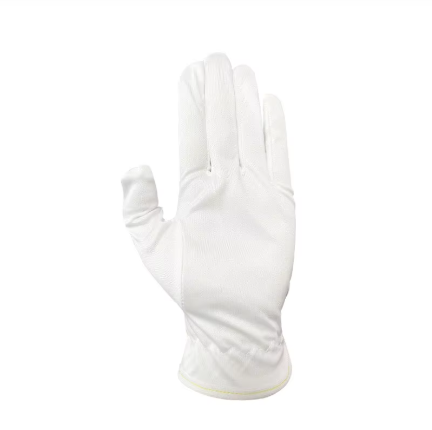Nezbytná ochrana v moderních výrobních prostředích
Ve dnešní výrobní oblasti zaměřené na přesnost rukavice pro čisté provozy se staly nezbytnou součástí kontrol kvality a bezpečnostních protokolů pro pracovníky. Tyto specializované rukavice slouží jako kritická bariéra mezi lidskými operátory a citlivými materiály, zajišťují integritu produktu a zároveň chrání pracovníky před potenciálně škodlivými látkami. Zavedení čistomístních rukavic ve různých výrobních odvětvích revolučně změnilo způsob, jakým průmysl udržuje své přísné standardy čistoty.
Výrobní zařízení po celém světě stále více uvědomují klíčovou roli, kterou čistomilové rukavice hrají ve svých provozních procesech. Od výroby polovodičů až po farmaceutickou výrobu se tyto specializované ochranné prostředky staly základním kamenem strategií kontroly kontaminace. Jejich význam jde dál než pouhá ochrana rukou a zahrnuje komplexní přístup ke zajištění kvality a dodržování předpisů.
Klíčové výhody pro kontrolu kvality výrobků
Vynikající prevence kontaminace
Rukavice do čistých prostor poskytují výjimečnou bariéru proti mikroskopickým částicím, olejům a biologickým kontaminantům, které mohou ohrozit kvalitu produktu. Pokročilé materiály použité při jejich výrobě účinně zabraňují přenosu pokožkových buněk, vlasů a jiných částic, které se přirozeně uvolňují z lidských rukou. Tato úroveň ochrany je obzvláště důležitá v odvětvích, kde i nejmenší kontaminace může vést k selhání nebo zamítnutí výrobku.
Vícevrstvá konstrukce rukavic do čistých prostor obsahuje specializované polymery, které zachycují potenciální kontaminanty a zároveň zachovávají obratnost nositele. Tento sofistikovaný inženýrský přístup zajišťuje, že výrobní procesy zůstávají nepolamované a pracovníci mohou provádět přesné úkony s minimálním omezením.
Zvýšení konzistence produktu
Výrobní konzistence závisí značně na udržování kontrolovaného prostředí a čistomístné rukavice hrají klíčovou roli při dosažení tohoto cíle. Tím, že vytvářejí spolehlivou bariéru mezi obsluhou a výrobky, pomáhají zajistit konzistenci mezi jednotlivými výrobními šaržemi. Tato standardizace je obzvláště důležitá v odvětvích, kde přímo ovlivňuje uniformita výrobku spokojenost zákazníků a soulad s předpisy.
Použití čistomístných rukavic také přispívá ke snížení počtu odmítnutých výrobků a ke zlepšení výtěžnosti výrobních procesů. Když jsou tyto specializované rukavice správně začleněny do komplexní strategie kontroly kontaminace, pomáhají udržet stabilitu a spolehlivost výrobních výstupů.

Funkce pro bezpečnost a pohodlí pracovníků
Pokročilé ochranné technologie
Moderní rukavice do čistých prostor jsou vyrobeny z pokročilých materiálů, které poskytují vysokou ochranu proti chemické expozici a fyzickým nebezpečím. Pečlivě vybrané sloučeniny použité při jejich výrobě vytvářejí účinnou bariéru, aniž by byla narušena pružnost a pohodlí nošení. Tato pokročilá ochrana pokrývá jak rizika akutní, tak chronické expozice, a chrání pracovníky po celou dobu jejich směny.
Nejnovější vývoj v technologii rukavic pro čisté prostory vedl k výrobě modelů s vylepšenou odolností vůči chemikáliím, čímž jsou vhodné pro použití s širším spektrem průmyslových látek. Tato univerzálnost zajišťuje, že pracovníci zůstávají chráněni bez ohledu na konkrétní výrobní procesy, ve kterých jsou zapojeni.
Zohlednění ergonomického návrhu
Ergonomické vlastnosti rukavic pro čisté prostory byly pečlivě navrženy tak, aby snížily únavu rukou a zlepšily pohodlí pracovníků při delším používání. Anatomický tvar a pružné materiály umožňují přirozený pohyb ruky, aniž by byly kompromitovány nezbytné ochranné vlastnosti. Tato pozornost věnovaná pohodlí přímo přispívá ke zvýšení produktivity pracovníků a snižuje výskyt úrazů způsobených opakovaným zatěžováním.
Výrobci nyní nabízejí rukavice pro čisté prostory v různých velikostech a stylech, čímž zajišťují optimální sednutí pro různé velikosti rukou a aplikace. Tato možnost personalizace pomáhá udržet po celou dobu dlouhých směn jak úroveň ochrany, tak pohodlí uživatele.
Dodržování předpisů a průmyslových standardů
Splnění požadavků globální výroby
Čistomírové rukavice hrají klíčovou roli při napomáhání výrobním zařízením splňovat přísné regulační požadavky v různých oblastech a odvětvích. Tyto specializované rukavice jsou navrženy tak, aby vyhovovaly mezinárodním normám pro kontrolu částic, sterilitu a odolnost vůči chemikáliím. Jejich použití pomáhá zařízením udržet si certifikační stav a s jistotou projít regulačními audity.
Dokumentační a testovací postupy spojené s čistomírovými rukavicemi poskytují nezbytné důkazy pro systémy řízení kvality a programy dodržování předpisů. Tento komplexní přístup k validaci zajišťuje, že výrobní procesy trvale splňují nebo převyšují průmyslové standardy.
Dokumentace a sledovatelnost
Moderní rukavice do čistých prostor jsou dodávány s podrobnou dokumentací týkající se jejich výrobních procesů, výsledků testování a opatření k zajištění kvality. Tato dokumentace podporuje požadavky na stopovatelnost a pomáhá udržovat podrobné záznamy pro účely dodržování předpisů. Schopnost sledovat a ověřovat kvalitu ochranného vybavení používaného ve výrobních procesech získává v dnešním regulačním prostředí stále větší význam.
Pravidelné testování a certifikace rukavic do čistých prostor zajišťují trvalou shodu s průmyslovými normami a poskytují doložené důkazy opatření ke kontrole kvality. Tento systematický přístup k dokumentaci podporuje jak interní programy zajištění kvality, tak požadavky externích auditů.
Nákladová účinnost a operační efektivita
Dlouhodobé ekonomické přínosy
I když počáteční investice do vysoce kvalitních rukavic pro čisté prostory může působit významně, jejich použití obvykle vede k výraznému úspornému efektu v průběhu času. Předcházení kontaminaci produktů a snížení míry odmítnutí výrobků přímo ovlivňuje konečný výsledek. Navíc odolnost a spolehlivost prémiových rukavic pro čisté prostory často znamená nižší frekvenci výměny a menší množství odpadu.
Ekonomické výhody sahají dále než pouze přímé náklady na materiál a zahrnují snížení problémů s kontrolou kvality, méně výrobních prodlev a zlepšenou celkovou provozní efektivitu. Tyto sdružené benefity činí rukavice pro čisté prostory nákladově efektivním řešením pro výrobní zařízení zaměřená na dlouhodobý úspěch.
Zlepšení produktivity
Použití vhodných rukavic do čistých prostor může výrazně zvýšit produktivitu pracoviště. Díky spolehlivé ochraně, aniž by byla omezena obratnost, umožňují tyto rukavice pracovníkům udržovat vysokou úroveň výkonu a zároveň zajišťují kvalitu výrobků. Snížení problémů souvisejících s kontaminací také znamená méně výrobních přerušení a nutnosti dodatečné práce.
Zjednodušené procesy a snížený výpadek spojené s řádným používáním rukavic do čistých prostor přispívají ke zlepšené provozní efektivitě a vyšším výrobním výkonům. Tato optimalizace zdrojů a času přináší měřitelné výhody pro výrobní operace všech velikostí.
Nejčastější dotazy
Jak často by měly být rukavice do čistých prostor měněny během výrobních procesů?
Frekvence výměny rukavic závisí na několika faktorech, včetně konkrétního výrobního prostředí, druhu prováděné práce a expozice kontaminantům. Obecně by měly být rukavice měněny každé 2–4 hodiny, když jsou viditelně znečištěné, po přestávkách nebo při přechodu mezi různými čistými zónami. Některé kritické procesy mohou vyžadovat častější výměnu za účelem udržení optimální úrovně ochrany.
Jaké materiály se běžně používají při výrobě čistomístních rukavic?
Mezi běžné materiály patří nitril, latex a neopren, z nichž každý nabízí specifické výhody pro různé aplikace. Rukavice z nitrilu jsou obzvláště populární díky své vynikající odolnosti vůči chemikáliím a trvanlivosti, zatímco latex poskytuje nadstandardní pružnost a pohodlí. Volba materiálu závisí na faktorech, jako je chemická kompatibilita, riziko alergií a konkrétní požadavky čistomístí.
Jak mohou výrobci zajistit správnou paspoň a velikost čistomístních rukavic?
Správné velikosti jsou rozhodující pro ochranu i pohodlí. Výrobci by měli zavést komplexní program týkající se velikostí, který bude zahrnovat měření rukou a zkoušení při pokusech o nasazení. Pravidelné hodnocení přiléhání a zpětná vazba zaměstnanců ohledně pohodlí pomáhají udržet optimální úroveň ochrany a zároveň zajišťují spokojenost zaměstnanců a dodržování bezpečnostních protokolů.




